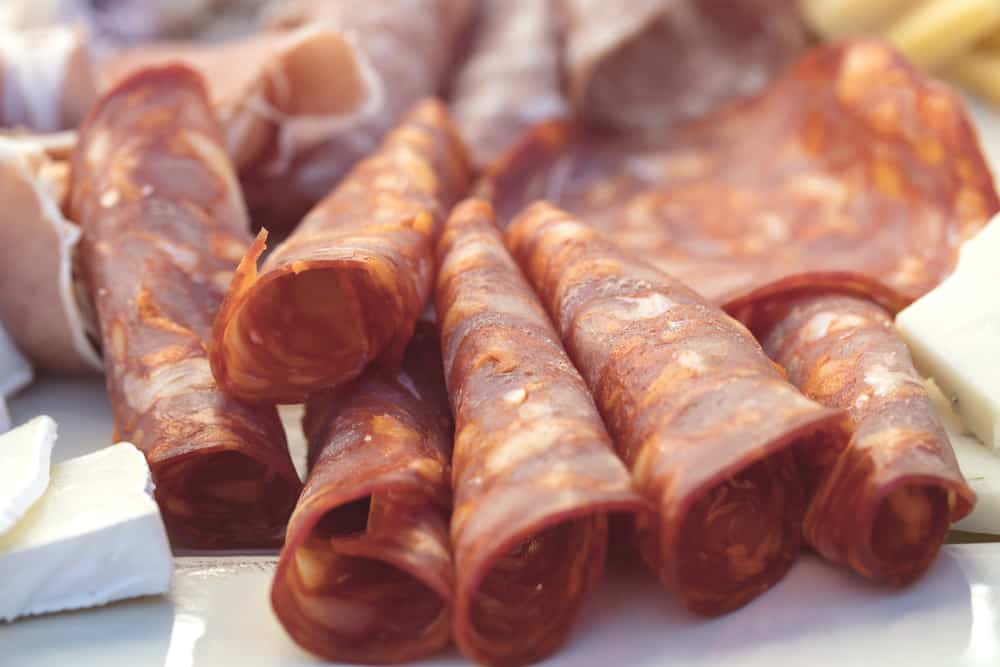
Over the course of years, the popularity and utilization of processed meat have increased. For the same reason, there are different types and shapes of processed meat, such as sopressata vs genoa salami. Still, it’s hard to differentiate between these two types of processed meat but we are sharing complete details about both these processed meat types.
Genoa Salami vs Sopressata
Genoa Salami
Salami has always been around and is known to be the fermented dry sausage which is packed with a large diameter casing. It generally has a rough form and the flavor is extremely specific. For the most part, there is garlic flavor and it can be eaten without cooking it. In addition, it is mixed and combined with pulverized spices and is wrapped up. For the most part, genoa salami is made from animal fat, spices, and minced meat.
Some varieties also have additional lactic acid bacteria which pass through the fogging process. As far as meat-type is concerned, it’s made from pork but some people have been making it with beef and veal as well.
It has red wine as well which leads to an acidic and rather funky flavor. In addition, the texture is pretty soft. It has a medium grind and the finish is pretty clean. Genoa salami also has a smooth and rich flavor and is native to the Genoa region (yes, it’s in Italy).
As far as the ingredients are concerned, it has natural flavoring, spices, sea salt, garlic, sugar, and starter culture along with meat. This processed meat is extremely delicious and pairs well with various dishes, such as Fontana cheese, roasted peppers, sparkling Prosecco, and warm bread (it makes such a delicious meal). As for seasoning, it can be seasoned with black pepper, white pepper, garlic, and red wine (white wine is also acceptable). Not to forget, there is a basic fermented flavor in genoa salami.
When we are talking about wine, both red and white wines are suitable. However, which wine you use will impact the color of genoa salami but the flavor will be fine. Also, we would like to add that genoa salami made with pork tastes better as compared to one made with beef and veal.
Sopressata
To begin with, this is the Italian salami (yes, it’s a dry one too). There are multiple variations of Sopressata but the major difference is curing (some of them are cured while some are uncured). Generally, the cured version is made in Calabria, Apulia, and Basilicata while the uncured variant is made in Liguria and Tuscany. Sopressata was made from fresh hams but other wounds can be used as well. For the most part, pork is used but beef can be used as well.
The meat is grounded and pressed to make a rustic and uneven texture when it is sliced (it looks good). In addition, it is dried for three weeks to twelve weeks during which they lose 30% of the weight (the final diameter will depend on how thick the processed meat was). The cured variant is generally preserved and stores in olive oil bottles. As far as consumption is concerned, it’s cut into thin slices and is served with bread.
This salami is flavored with Calabrian chile peppers or black pepper which improves the flavor. As far as the texture is concerned, it’s chewy and firm. The salami belongs to Italy but is quite popular in the US.
In addition, it is available in spicy as well as mild versions (Calabrian chile peppers are used in spicy version while the mild one has black pepper). To be honest, the salami has a bold flavor. If you are concerned about other flavors, there is sea salt, garlic, sugar, and starter culture.
It can be served with fresh goat cheese, seeded crackers, wheat beer, or dry rose wine. Also, there are three types of Sopressata, such as;
- Sopressata Toscana – this is the Tuscan version and is made with the leftover pig parts (yes, even the head is used). In addition, it uses a combination of skin and meat to make the ground meat and it’s chopped and seasoned to enhance the flavor
- Sopressa Veneta – it is made by pressing salami between wooden planks which leads to a flat and straight shape
- Sopressata di Basilicata – it is famous and produced in Lagonegro, Rivello, Vaglio, and Cancellara